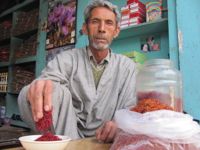AFGHANISTAN: Killing Heroin With Saffron

Weaning Afghanistan’s poppy farmers away from growing the raw material for the bulk of the world’s illicit heroin has never been easy, but Kashmir’s saffron cultivators may have the answer.
A high-value crop, saffron has long been seen as a counternarcotics candidate, but the idea has a chance of coming to fruition with expertise from farmers in India’s Jammu and Kashmir state who produce the finest saffron anywhere.
An agreement signed in February between the agriculture ministries of the two countries paved the way for a 25-member delegation from Afghanistan to visit Jammu and Kashmir in November and see how the state’s success with saffron can be emulated.
After touring Pampore, the main centre for the saffron industry, located 14 km east of Srinagar, delegation chief Naseem Atai told IPS that he was hopeful of a 'change of choice' in his country.
'Once our farmers grow saffron in the manner of their Kashmiri counterparts, they will certainly find it a profitable agricultural activity and they may ultimately give up growing poppy,' Atai said.
'We have seen how Kashmiri farmers are earning good dividends by growing saffron. We can do the same for Afghanistan if we adopt the same methods and techniques.'
Afghan farmers, said Atai, have already been growing saffron since 2000 in Heart province near Iran’s border, 'but the yield and quality are not good since the farmers have no expertise or access to good technology.'
Iran and Spain are the two other countries where saffron is grown, with Iran producing 85 percent of the world’s supply. But, the quality of Kashmiri saffron - essentially the dried stamen of the flower - is considered to be far superior to that grown elsewhere in the world.
Saffron is sought after for the aroma, colour and flavour it imparts to rice and other foodstuffs. It has also been used for centuries in traditional medicines and as a natural pigment.
S. A. Nahvi, who heads the central government’s saffron mission in Jammu and Kashmir, says that the state’s saffron production has been improving with the introduction of superior cultivation methods and technology.
'We have already modernised 355 hectares out of the 4,000 hectares under saffron,' Nahvi said. 'Over the last few years there was a decline in production, but that has been reversed.
'We showed the Afghan delegation what we are doing to improve our own saffron production. We took them to the saffron fields and on visits to families engaged in processing saffron at home.'
One reason why saffron has high value is that the production involves much labour before and after harvesting. The blossoms need to be picked in the early mornings as they open and transported with care to the homes or factories where the stigmas are separated from the flowers.
Depending on the variety, some 400,000 or more stigmas may go into the making of one kilogram of saffron. The work must be done by hand and since it calls for nimbleness, the industry holds out employment prospects for large numbers of women.
Saffron is considered the world’s costliest spice, and Kashmiri varieties currently fetch 3,600 dollars per kg although prices in recent years have gone as high as 6,000 dollars per kg.
According Nahvi since the soil and climatic conditions in Afghanistan are similar to that in Kashmir, 'they shouldn’t have any problems growing this crop if they adopt similar methods and techniques.'
Kashmir’s agriculture minister Ghulam Hassan Mir told IPS that Afghan delegations will continue to visit Kashmir to learn about the cultivation of saffron as well as other horticultural products.
'The Afghan government has indicated that it is keen to wipe out poppy cultivation and we are very much interested in helping them achieve their objective,' he told IPS.
Support from India to prop up various sectors of Afghanistan’s economy was formalised under a ‘strategic partnership agreement’ signed in New Delhi during a visit by Afghan President Hamid Karzai in the first week of October.
That agreement came even as the United Nations Drug Control Agency released the report of a survey which showed land under poppy cultivation in Afghanistan increasing as a result of rising opium prices on the one hand and economic hardships faced by Afghans on the other.
According to the Food and Agriculture Organisation, while Afghanistan's National Drug Control Strategy aims to eliminate illicit opium poppy cultivation by 2013, the U.N. survey found that poppy is now grown in 17 of the country’s provinces compared to 14 a year ago.
Poppy cultivation in Afghanistan has defied efforts by the U.S. and its NATO allies to destroy poppy fields since opium and heroin are known to generate revenues for fundamentalist militant organisations starting with the Taliban.
'Cultivation of poppy has devastated our agriculture and reputation. Our country is now known more for poppy and conflict than for any positive activity. We want to change that,' said Asadullah Aurakzai, a member of the delegation.
© Inter Press Service (2011) — All Rights ReservedOriginal source: Inter Press Service
 Global Issues
Global Issues